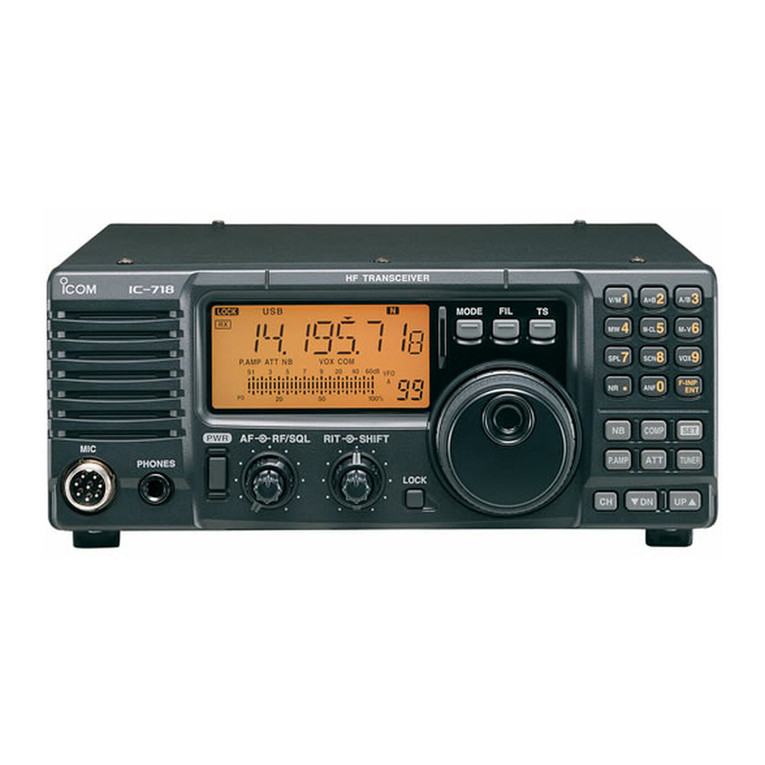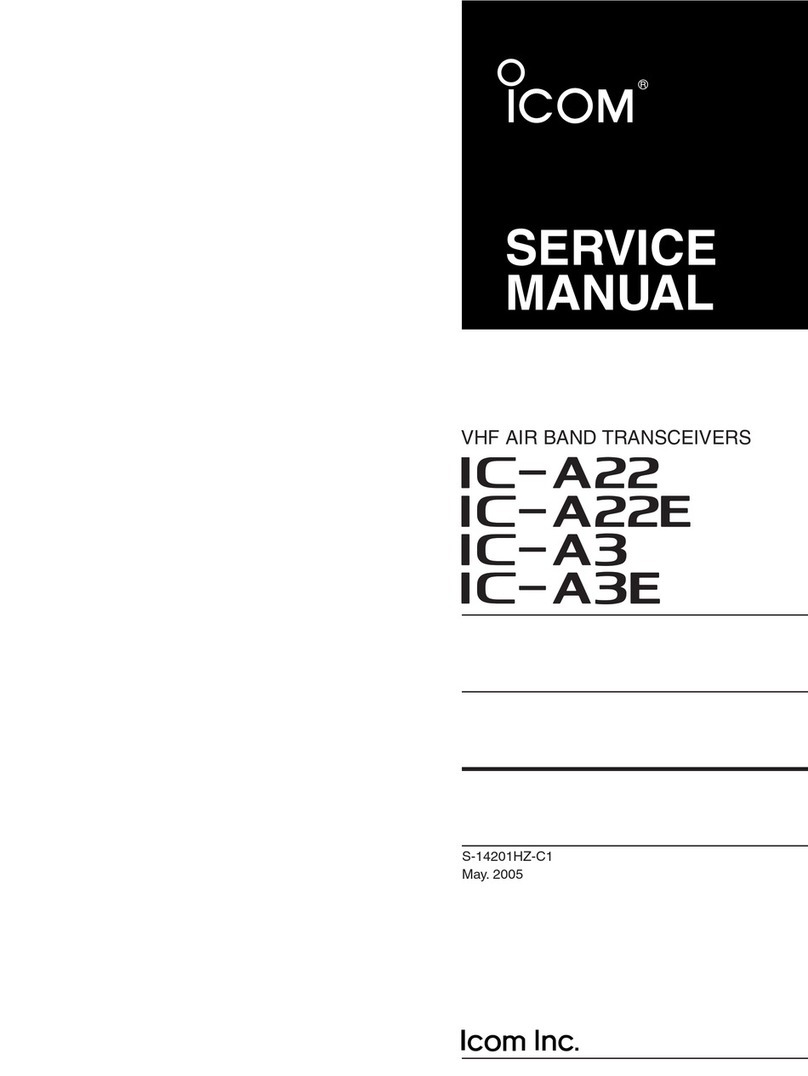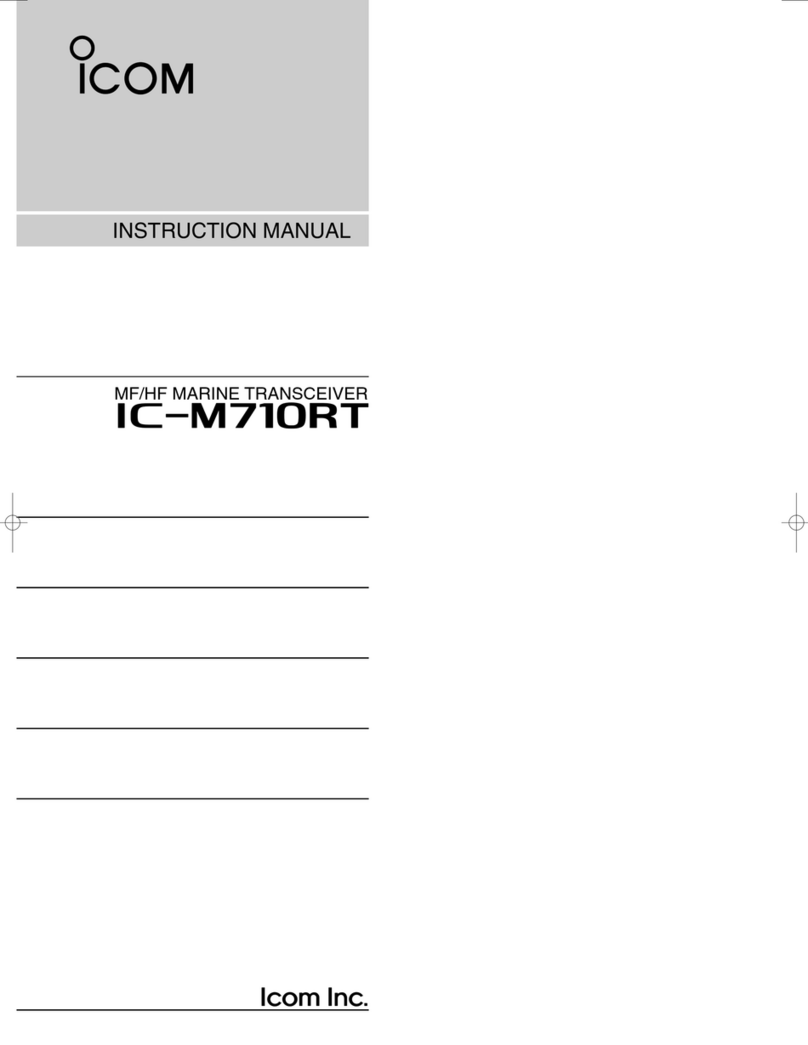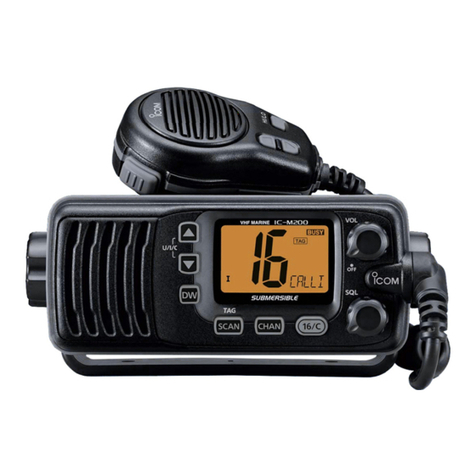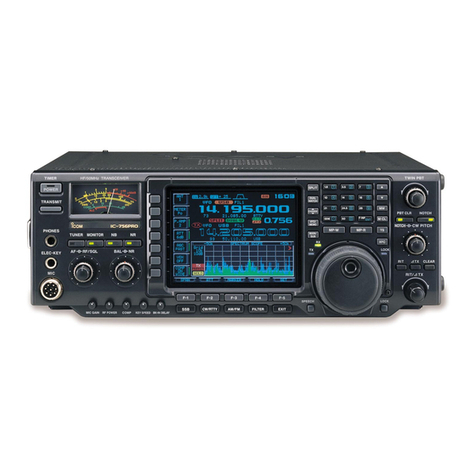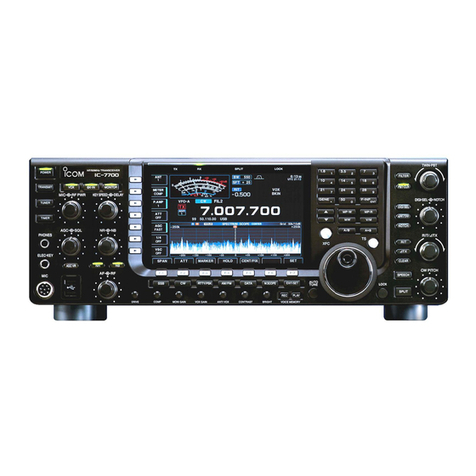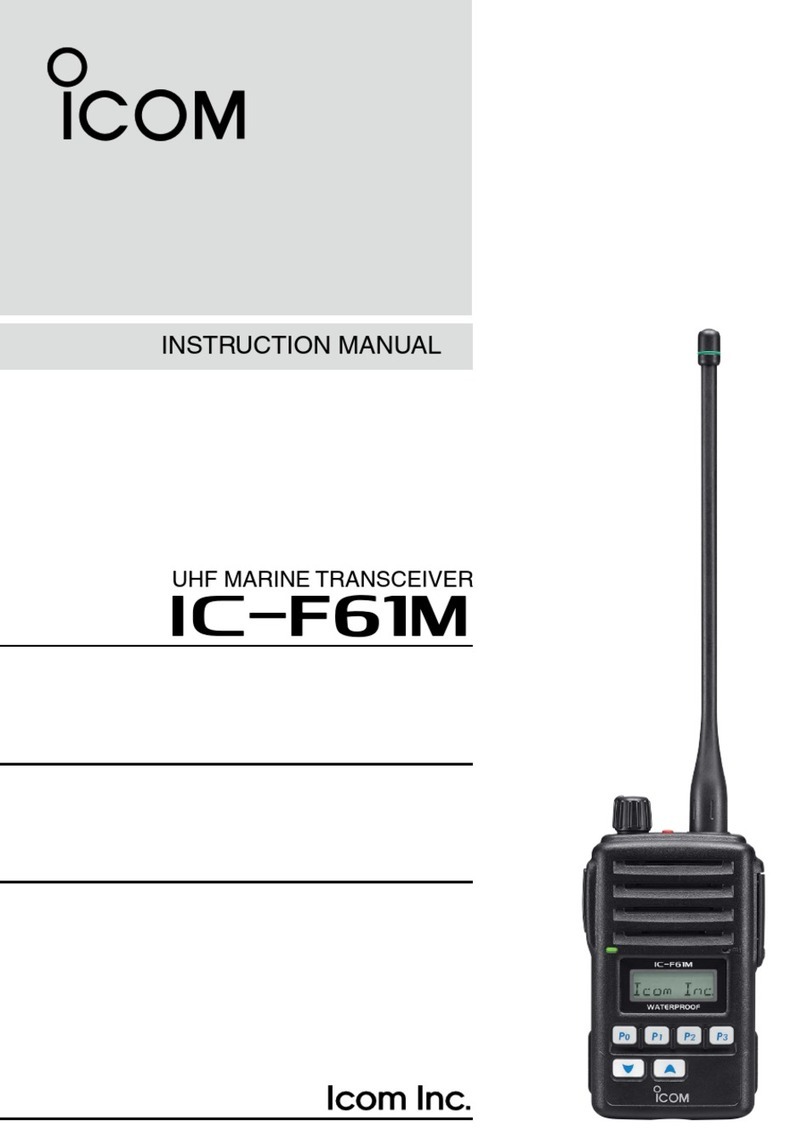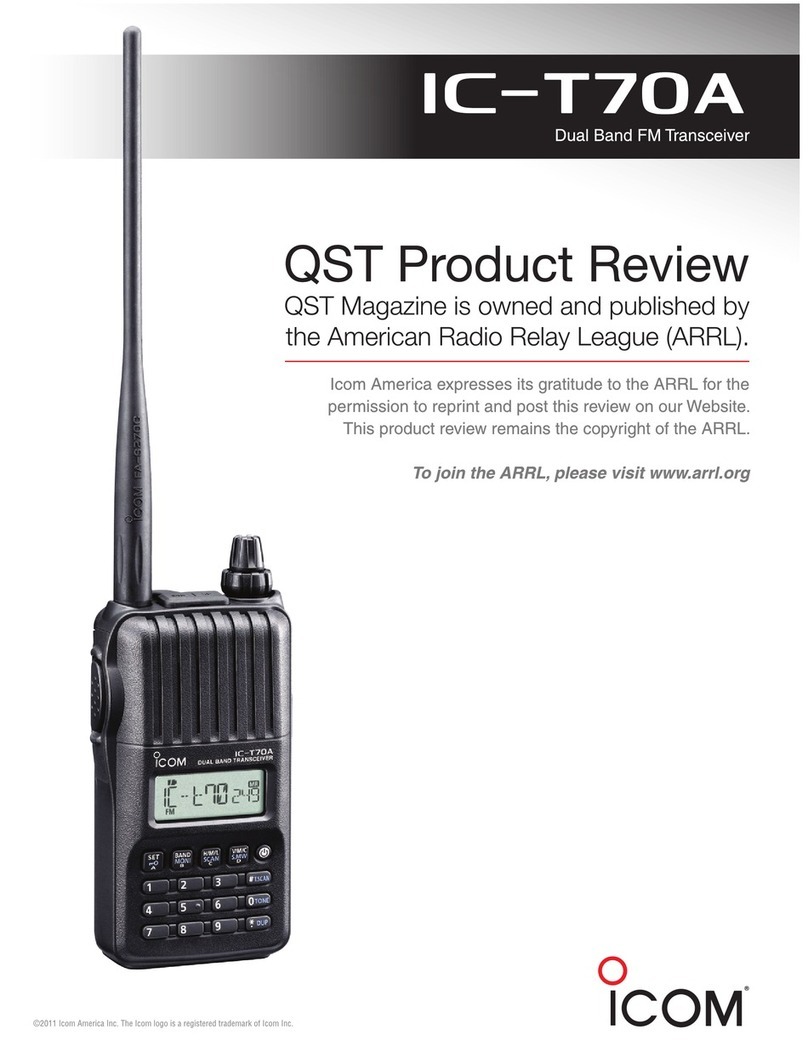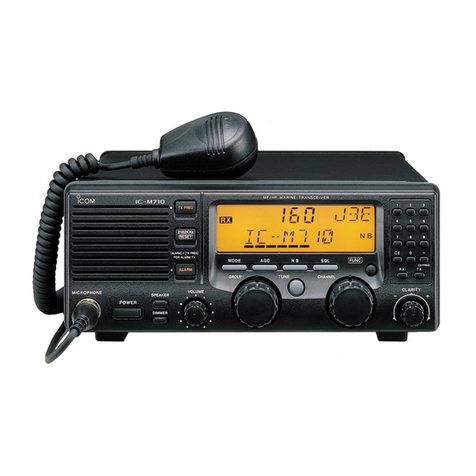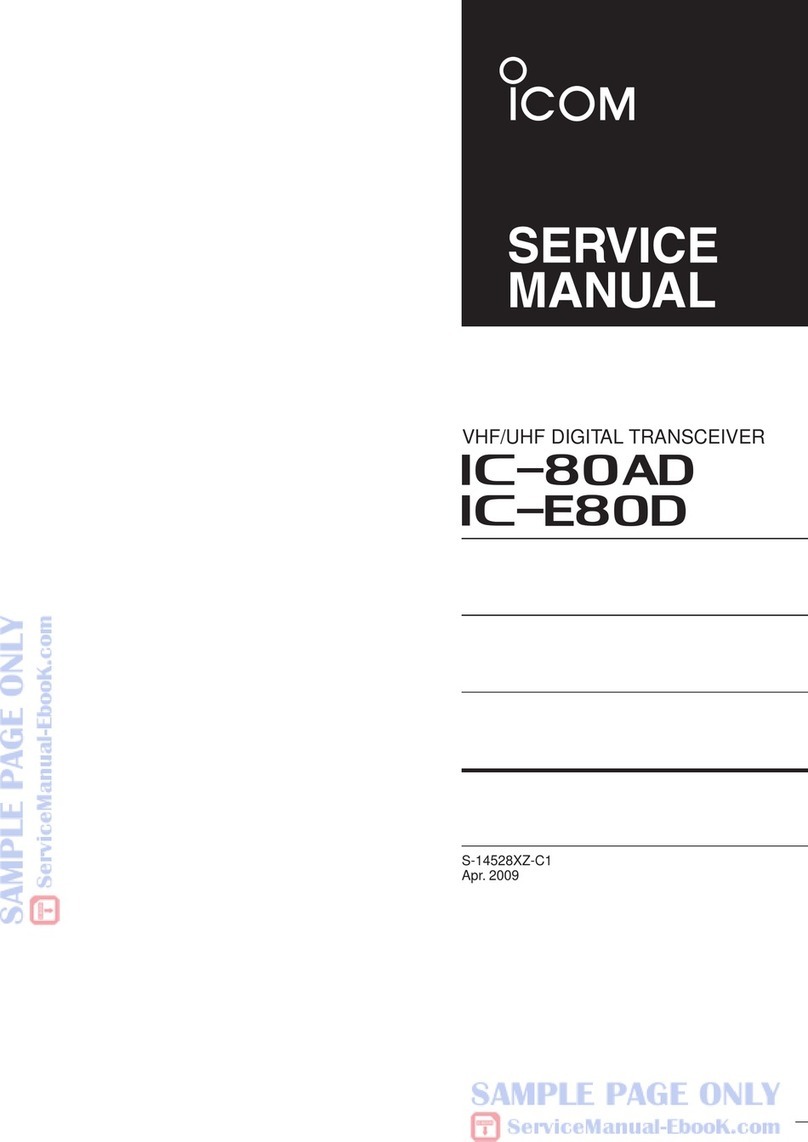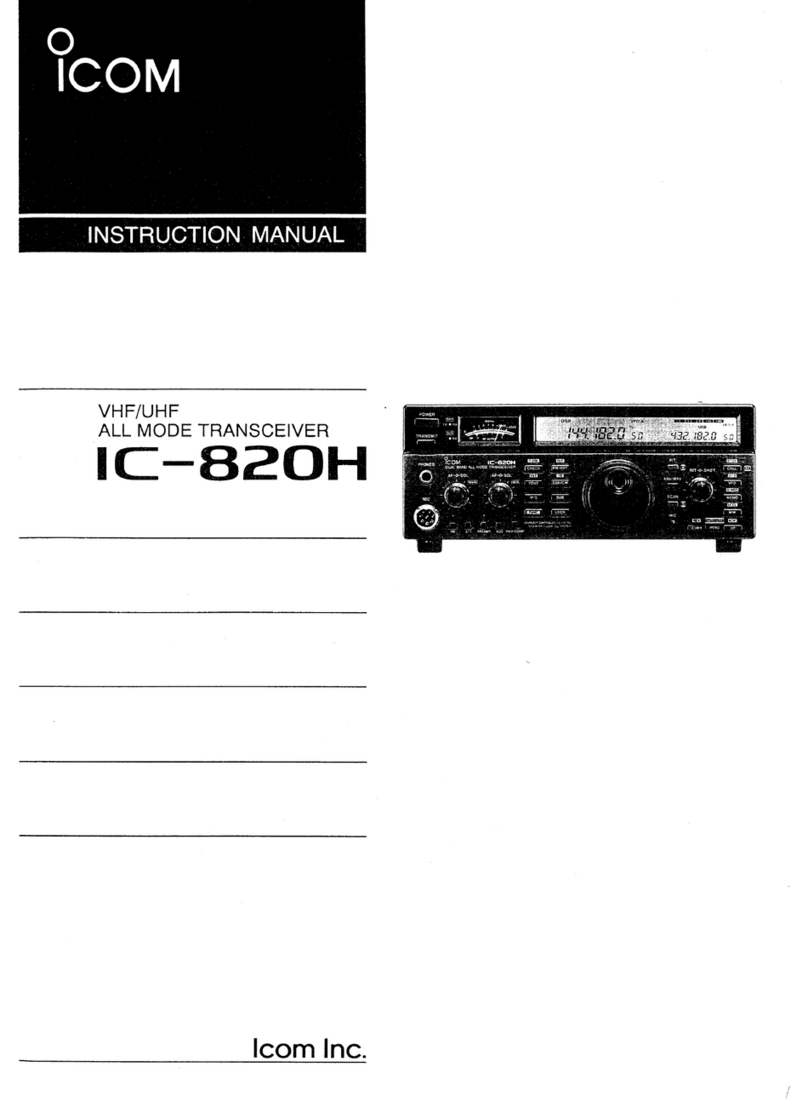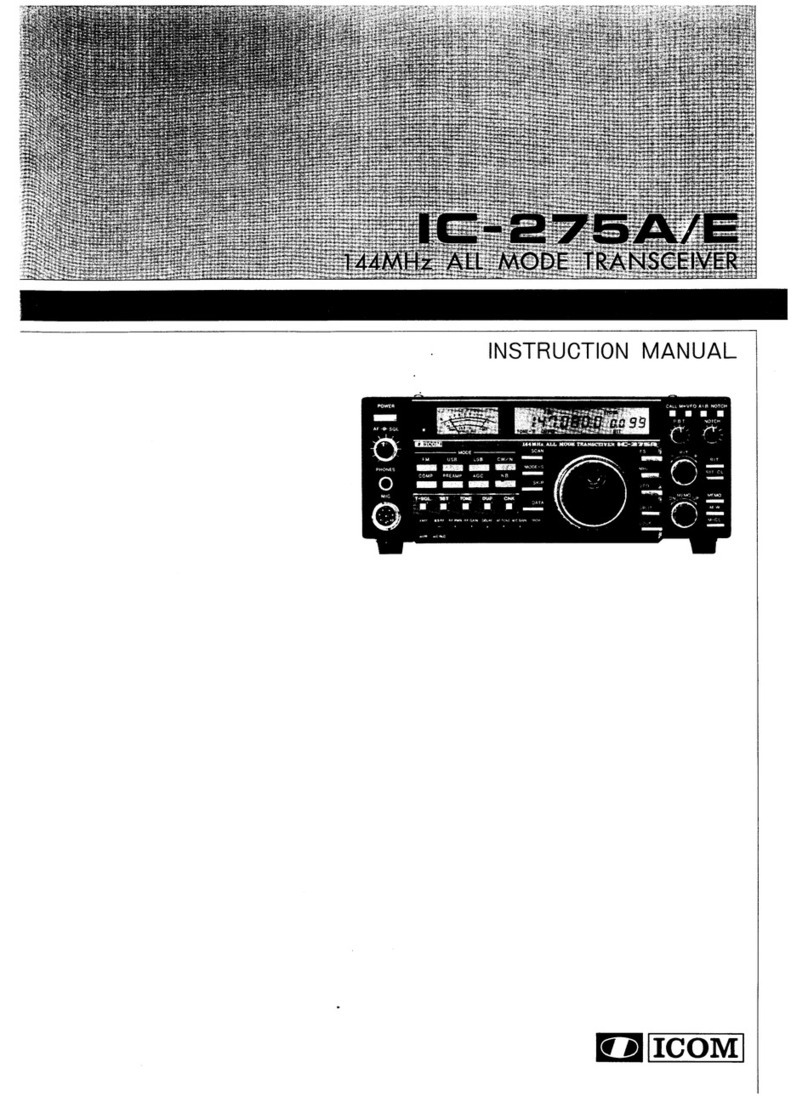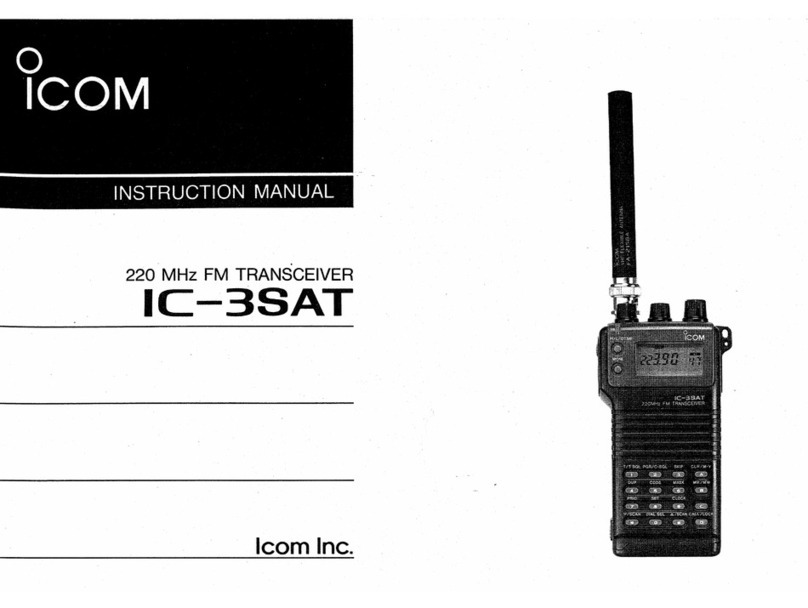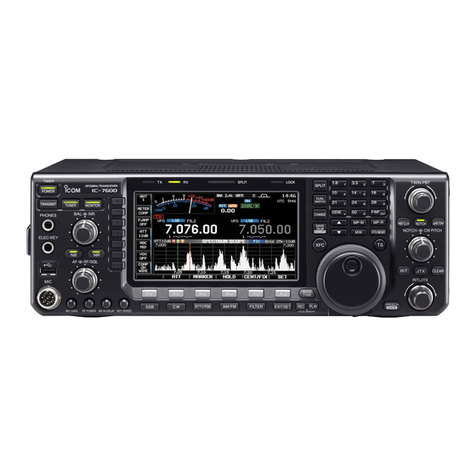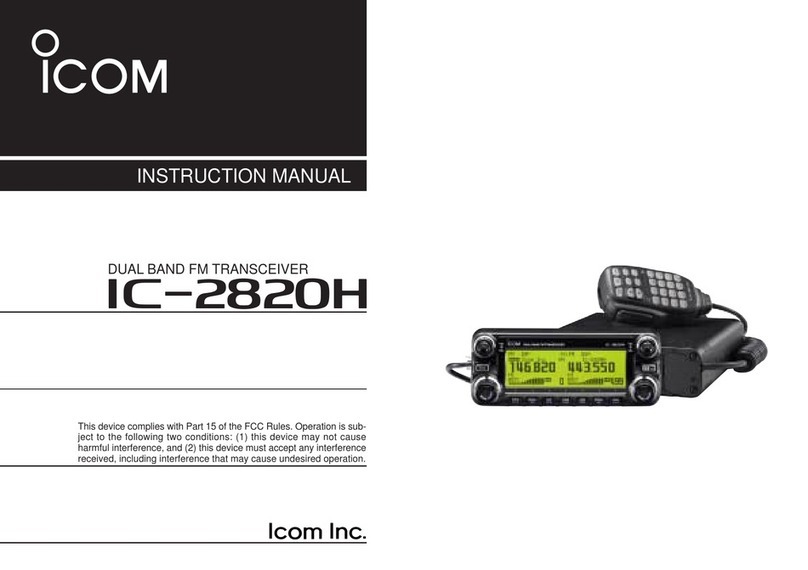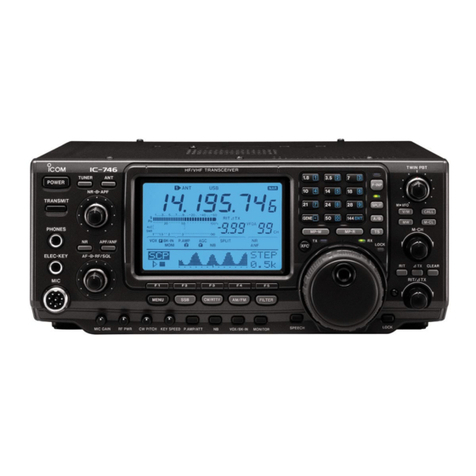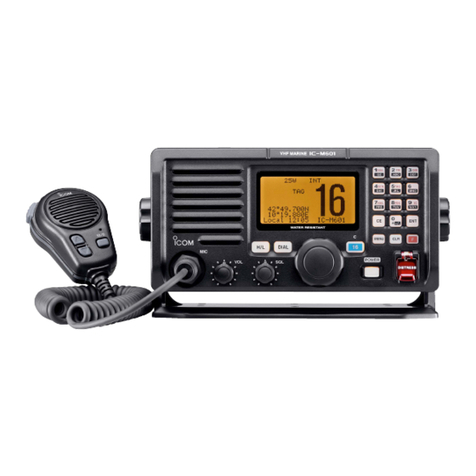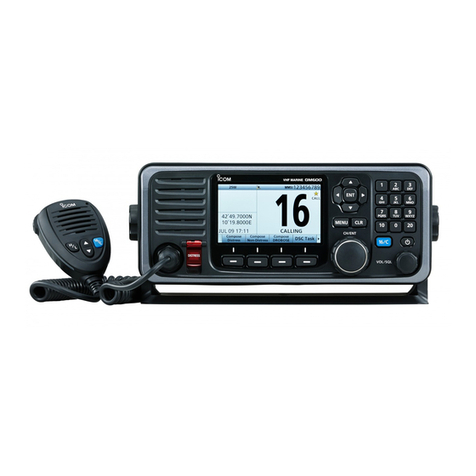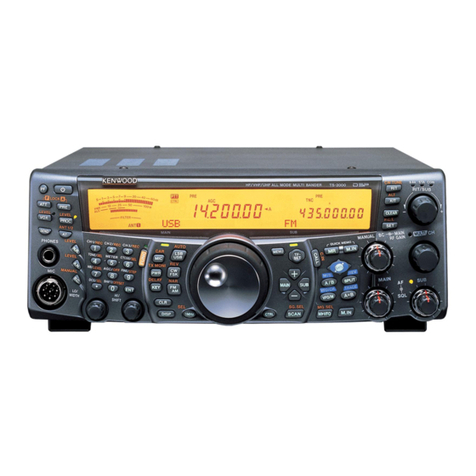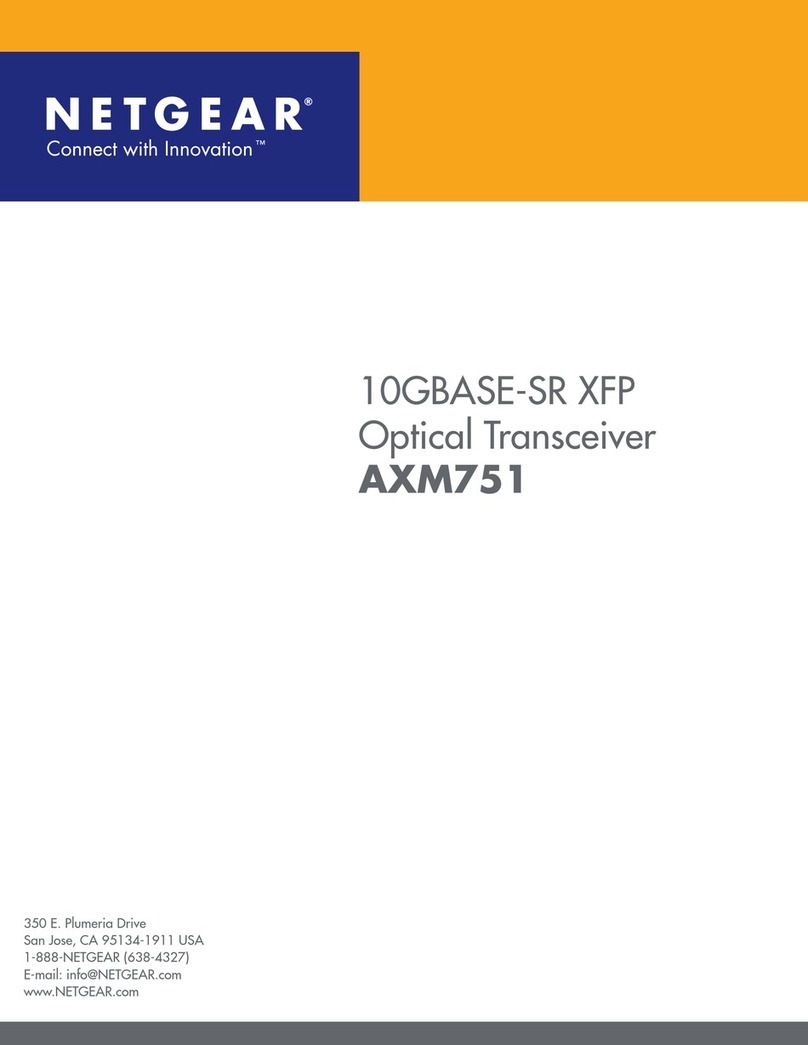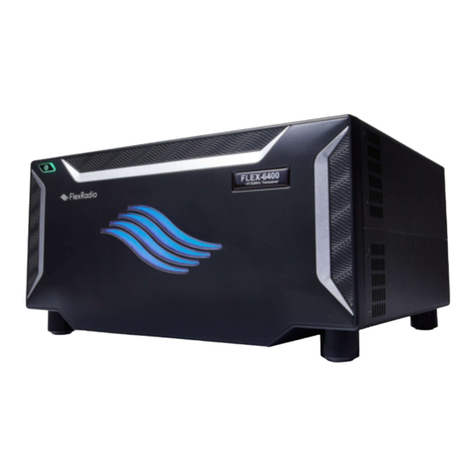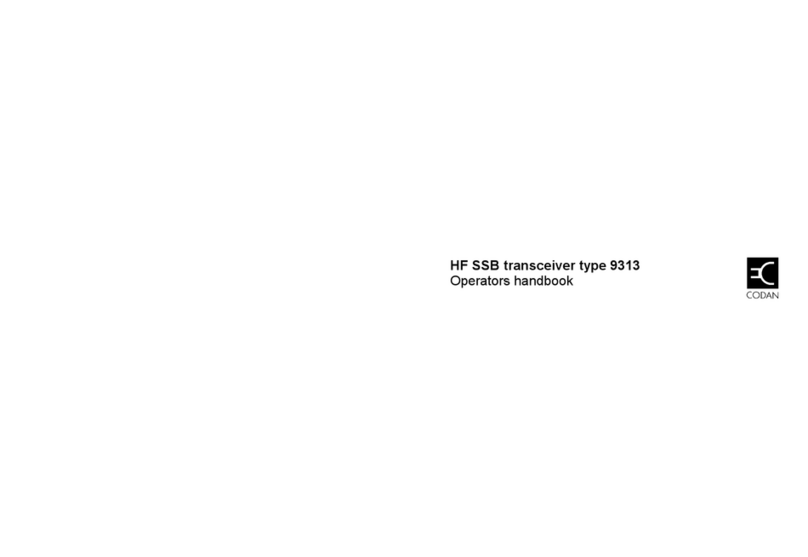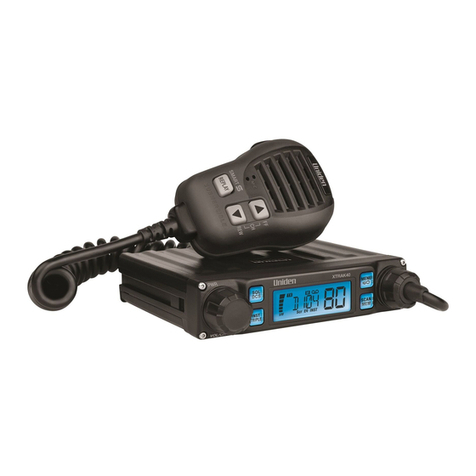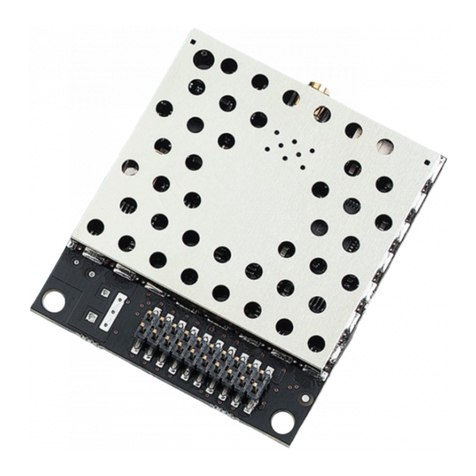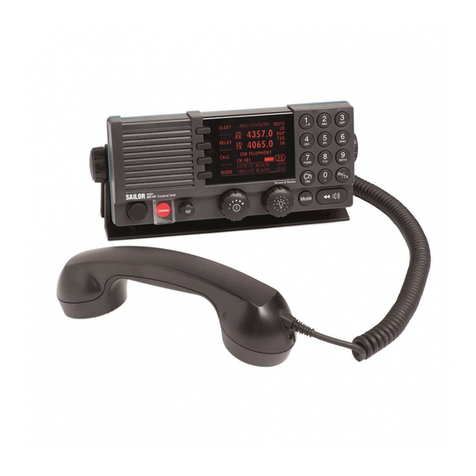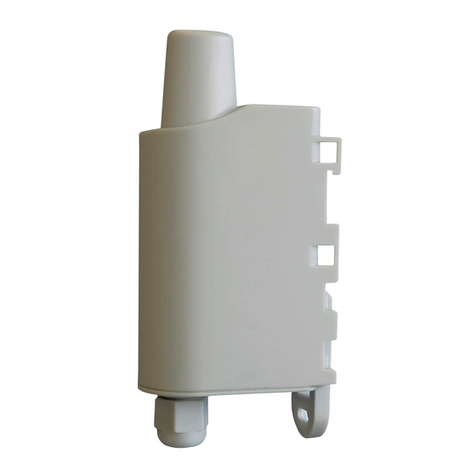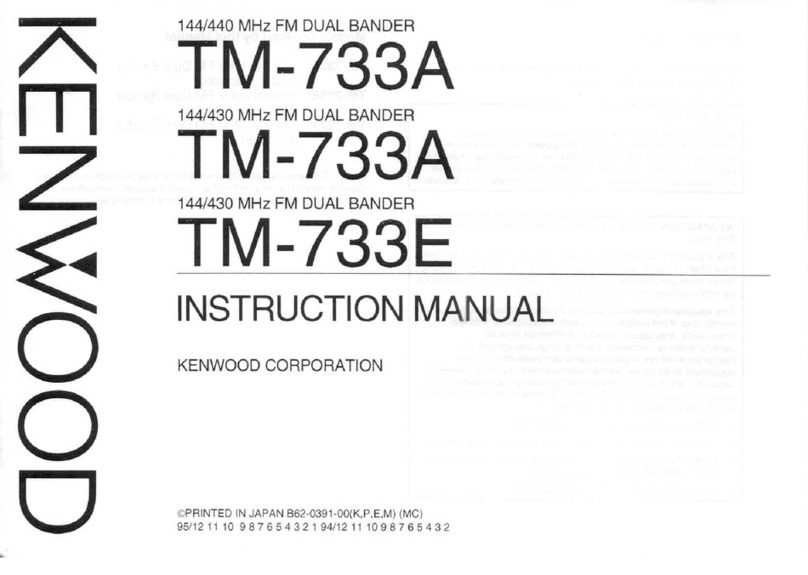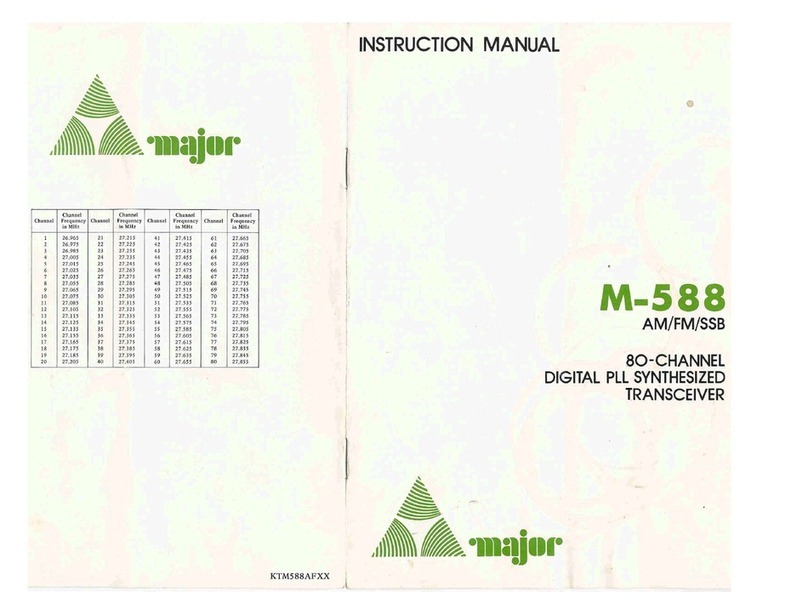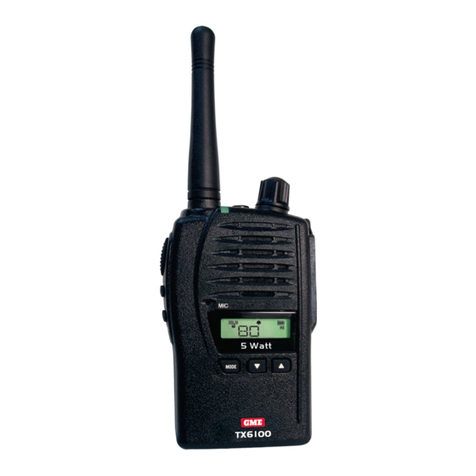Icom IC-M88 User manual

INSTRUCTIONMANUAL
iM88
VHFMARINETRANSCEIVER
ThisdevicecomplieswithPart15ofthe
FCC Rules. Operation is subject to the con-
dition that this device does not cause harm-
ful interference.

WARNING
Your Icom radio generates RF electromagnetic energy dur-
ing transmit mode. This radio is designed for and classified
as “Occupational Use Only”, meaning it must be used only
during the course of employment by individuals aware of the
hazards, and the ways to minimize such hazards. This radio
is NOT intended for use by the “General Population” in an
uncontrolled environment.
This radio has been tested and complies with the FCC and IC RF exposure
limits for “Occupational Use Only”. In addition, your Icom radio complies with
the following Standards and Guidelines with regard to RF energy and electro-
magnetic energy levels and evaluation of such levels for exposure to humans:
•FCCOETBulletin65Edition97-01SupplementC,EvaluatingCompli-
ancewithFCCGuidelinesforHumanExposuretoRadioFrequencyElec-
tromagnetic Fields.
•AmericanNationalStandardsInstitute(C95.1-1992),IEEEStandardfor
SafetyLevelswithRespecttoHumanExposuretoRadioFrequencyElec-
tromagneticFields,3kHzto300GHz.
•AmericanNationalStandardsInstitute(C95.3-1992),IEEERecommended
PracticefortheMeasurementofPotentiallyHazardousElectromagnetic
Fields– RF and Microwave.
•Thefollowingaccessoriesareauthorizedforusewiththisproduct.Useof
accessories other than those specified may result in RF exposure levels
exceedingtheFCCandICrequirementsforwirelessRFexposure.;Belt
Clip(MB-79),SwivelBeltClip(MB-86),RechargeableLi-ionBatteryPack
(BP-227),AlkalineBatteryCase(BP-226)andSpeaker-microphone(HM-
138).
CAUTION
To ensure that your expose to RF electromagnetic en-
ergy is within the FCC and IC allowable limits for occu-
pational use, always adhere to the following guidelines:
•DO NOT operate the radio without a proper antenna attached, as this may
damaged the radio and may also cause you to exceed FCC and IC RF ex-
posurelimits.Aproperantennaistheantennasuppliedwiththisradioby
the manufacturer or antenna specifically authorized by the manufacturer
for use with this radio.
•DO NOTtransmitformorethan50%oftotalradiousetime(“50%duty
cycle”).Transmittingmorethan50%ofthetimecancauseFCCandICRF
exposurecompliancerequirementstobeexceeded.Theradioistransmit-
ting when the “TX indicator” lights red. You can cause the radio to transmit
by pressing the “PTT” switch.
•ALWAYS keeptheantennaatleast2.5cm(1inch)awayfromthebody
when transmitting and only use the Icom belt-clips which are listed on
page 33 when attaching the radio to your belt, etc., to ensure FCC and IC
RFexposurecompliancerequirementsarenotexceeded.Toprovidethe
recipientsofyourtransmissionthebestsoundquality,holdtheantennaat
least5cm(2inches)fromyourmouth,andslightlyofftooneside.
The information listed above provides the user with the information needed
to make him or her aware of RF exposure, and what to do to assure that this
radio operates with the FCC and IC RF exposure limits of this radio.
Electromagnetic Interference/Compatibility
During transmissions, your Icom radio generates RF energy that can possibly
cause interference with other devices or systems. To avoid such interference,
turn off the radio in areas where signs are posted to do so. DO NOT operate
the transmitter in areas that are sensitive to electromagnetic radiation such as
hospitals, aircraft, and blasting sites.
Occupational/Controlled Use
The radio transmitter is used in situations in which persons are exposed as
consequenceoftheiremploymentprovidedthosepersonsarefullyawareof
the potential for exposure and can exercise control over their exposure.
SAFETYTRAININGINFORMATION
i

FCCINFORMATION
• FOR CLASS A UNINTENTIONAL RADIATORS:
Thisequipmenthasbeentestedandfoundtocomplywiththe
limitsforaClassAdigitaldevice,pursuanttopart15oftheFCC
Rules. These limits are designed to provide reasonable protec-
tionagainstharmfulinterferencewhentheequipmentisoper-
atedinacommercialenvironment.Thisequipmentgenerates,
uses,andcanradiateradiofrequencyenergyand,ifnotinstalled
and used in accordance with the instruction manual, may cause
harmful interference to radio communications. Operation of this
equipmentinaresidentialareaislikelytocauseharmfulinterfer-
enceinwhichcasetheuserwillberequiredtocorrecttheinter-
ference at his own expense.
INCASEOFEMERGENCY
Ifyourvesselrequiresassistance,contactothervesselsandthe
CoastGuardbysendingadistresscallonChannel16.
USING CHANNEL 16
DISTRESS CALL PROCEDURE
1.“MAYDAYMAYDAYMAYDAY.”
2.“THISIS.................”(nameofvessel)
3. Your call sign or other indication of the vessel.
4.“LOCATEDAT.................”(yourposition)
5.Statethenatureofthedistressandassistancerequired.
6.
Give any other information which might facilitate the rescue.
RECOMMENDATION
CLEAN THE TRANSCEIVER THOROUGHLY WITH FRESH
WATER after exposure to saltwater. Otherwise, the transceiv-
er’s keys, switches and controllers may become inoperable due
to salt crystallization.
NOTE: DO NOT wash the transceiver in water if there is any rea-
son to suspect the waterproofing may not be effective. For ex-
ample, in cases where the battery pack rubber seal is damaged,
the transceiver/battery pack is cracked or broken, or has been
dropped, or when the battery pack is detached from the trans-
ceiver.
ii

FOREWORD
ThankyouforpurchasingthisIcomproduct.TheIC-M88VHF
MARINETRANSCEIVER isdesigned andbuilt withIcom’s
stateofthearttechnologyandcraftsmanship.Withpropercare
this product should provide you with years of trouble-free oper-
ation.
IMPORTANT
READ ALL INSTRUCTIONS carefully and com-
pletely before using the transceiver.
SAVE THIS INSTRUCTION MANUAL—This
instruction manual contains important operating instructions
fortheIC-M88.
EXPLICITDEFINITIONS
WORD DEFINITION
RDANGER! Personal death, serious injury or an explo-
sion may occur.
RWARNING! Personal injury, fire hazard or electric
shock may occur.
CAUTION Equipmentdamagemayoccur.
NOTE
If disregarded, inconvenience only. No risk
of personal injury, fire or electric shock.
FEATURES
☞22 free channels for land use
TheIC-M88has22freechannelsreservedforLand
use
(146–174MHz).Wide/narrow
channel spacing is program-
mable for each channel, and CTCSS and DTCS signaling
is included.
*Appropriatelicensewillberequired.
☞Tough waterproof construction
TheIC-M88isbuilttoughtowithstandhazardousandun-
hospitableenvironmentsatseaandonland.Evenifthe
IC-M88isdroppedintowater,it’swaterproong*willpro-
tect it from harm. The compact and durable body meets
the military specifications (MIL-STD).
*EquivalenttoIPX7ofthecorrespondingInternationalStandard
IEC529(1989).(1mdepthfor30minutes)
☞Simple operation
6clearlylabelledbuttonsonthefrontpanelandthevol-
ume/powerknobmaximizesimplicityofoperation.Even
when wearing gloves, the large buttons are easy to oper-
ate.Alarge,clearLCDwithbacklightingandbacklitbut-
tons make night time operation simple.
☞Intrinsically safe (I/S) version available
iii

RWARNING! NEVER connect the transceiver to an
ACoutlet.Thismayposearehazardorresultinanelec-
tric shock.
RWARNING! NEVER hold the transceiver so that the
antenna is very close to, or touching exposed parts of the body,
especially the face or eyes, while transmitting. The transceiver
willperformbestifthemicrophoneis5to10cm(2to4inches)
away from the lips and the transceiver is vertical.
CAUTION: NEVER connect the transceiver to a power
source other than the specified battery pack/case. Such a
connection will ruin the transceiver.
DO NOT use or place the transceiver in direct sunlight
orinareaswithtemperaturesbelow–20°C(–4°F)orabove
+60°C (+140°F): Marine, below –30°C (–22°F) or above
+60°C(+140°F):LMR.
KEEP the transceiver out of the reach of children.
KEEP thetransceiveratleast0.9meters(3.0ft)awayfrom
your vessel’s magnetic navigation compass.
BE CAREFUL!ThetransceivermeetsIPX7*require-
ments for waterproof protection. However, once the trans-
ceiver has been dropped, waterproof protection cannot be
guaranteed because of possible damage to the transceiver's
case or the waterproof seal.
* Only when the battery pack, flexible antenna, [SP MIC] jack cover
is attached.
MAKE SURE the flexible antenna and battery pack are
securely attached to the transceiver, and that the antenna
andbatterypackaredrybeforeattachment.Exposingthein-
side of the transceiver to water will result in serious damage
to the transceiver.
Afterexposure towater,clean thebattery contactsthor-
oughly with fresh water and dry them completely to remove
any water or salt residue.
For U.S.A. only
CAUTION: Changes or modifications to this device, not
expressly approved by Icom Inc., could void your authority to
operate this device under FCC regulations.
VersionsoftheIC-M88whichdisplaythe
“FMAPPROVED”symbolasatleftonthe
serial number seal, conform to intrinsically
saferatingsoftheFMRC(FactoryMutual
ResearchCorporation).
Intrinsicallysafe :ClassI,II,III,Division1,
GroupsC,D,E,F,G
Nonincendive :ClassI,Division2,
GroupsA,B,C,D
Connectedbatterypack:BP-227FM
Icom, Icom Inc. and Icom logo are registered trademarks of Icom Incorpo-
rated(Japan)inJapan,theUnitedStates,UnitedKingdom,Germany,France,
Spain, Russia and/or other countries.
iv
PRECAUTIONS

v
TABLEOFCONTENTS
SAFETYTRAININGINFORMATION................................................. i
INCASEOFEMERGENCY............................................................. ii
RECOMMENDATION ....................................................................... ii
FOREWORD ................................................................................... iii
IMPORTANT.................................................................................... iii
EXPLICITDEFINITIONS................................................................. iii
FEATURES...................................................................................... iii
PRECAUTIONS............................................................................... iv
TABLEOFCONTENTS.................................................................... v
1 OPERATING RULES ..................................................................1
2 SUPPLIED ACCESSORIES AND ATTACHMENTS ...............2−3
3 PANEL DESCRIPTION ...........................................................4−7
■ Front, top and side panels .......................................................4
■ Function display.......................................................................6
4 BASIC OPERATION .............................................................8−12
■ Channel selection ....................................................................8
■ Receiving and transmitting ....................................................10
■Adjustingthesquelchlevel ....................................................11
■Automaticbacklighting ...........................................................11
■Voicescrambleroperation(AvailableforI/Sversiononly) .....11
■ Call channel programming.....................................................12
■ Lock function..........................................................................12
5 SCAN OPERATION ............................................................13−14
■ Scan types.............................................................................13
■ Setting tag channels ..............................................................14
■ Starting a scan.......................................................................14
6 DUALWATCH/TRI-WATCH .......................................................15
■ Description.............................................................................15
■ Operation...............................................................................15
7 LAND CHANNEL OPERATION................................................16
■LANDChannelGroup............................................................16
■ Function display.....................................................................16
8 SET MODE..........................................................................17−21
■SETmodeprogramming........................................................17
■SETmodeitems ....................................................................18
9 BATTERY CHARGING .......................................................22−26
■Batterycharging .................................................................... 22
■ Cautions.................................................................................22
■OptionalBP-226batterycase................................................24
■AD-100installation.................................................................25
■ Optional battery chargers ......................................................25
10 SPEAKER-MICROPHONE .......................................................27
■HM-138Description...............................................................27
■Attachments...........................................................................27
11 TROUBLESHOOTING ..............................................................28
12 VHF MARINE CHANNEL LIST.................................................29
13 SPECIFICATIONS.....................................................................30
14 QUICK REFERENCE..........................................................31−32
15 OPTIONS ..................................................................................33

D Priorities
•Readallrulesandregulationspertainingtoprioritiesand
keep an up-to-date copy handy. Safety and distress calls
take priority over all others.
•YoumustmonitorChannel16whenyouarenotoperating
on another channel.
•Falseorfraudulentdistresscallsareprohibitedunderlaw.
D Privacy
•Informationoverheardbutnotintendedforyoucannotlaw-
fully be used in any way.
•Indecentorprofanelanguageisprohibited.
D Radio licenses
(1) SHIP STATION LICENSE
WhenyourcraftisequippedwithaVHFFMtransceiver,you
must have a current radio station license before using the
transceiver. It is unlawful to operate a ship station which is
not licensed.
Inquirethroughyourdealerortheappropriategovernment
agency for a Ship-Radiotelephone license. This license in-
cludes the call sign which is your craft’s identification for radio
purposes.
(2) OPERATOR’S LICENSE
ArestrictedRadiotelephoneOperatorPermitisthelicense
most often held by small vessel radio operators when a radio
isnotrequiredforsafetypurposes.
The Restricted Radiotelephone Operator Permit must be
posted near the transceiver or be kept with the operator. Only
a licensed radio operator may operate a transceiver.
However, non-licensed individuals may talk over a trans-
ceiver if a licensed operator starts, supervises, ends the call
and makes the necessary log entries.
Acurrentcopyoftheapplicablegovernmentrulesandreg-
ulationsisonlyrequiredtobeonhandforvesselsinwhich
a radio telephone is compulsory. However, even if you are
notrequiredtohavetheseonhanditisyourresponsibility
tobethoroughlyacquaintedwithallpertinentrulesandreg-
ulations.
NOTE: EventhoughtheIC-M88iscapableofoperationon
VHFmarinechannels3,21,23,61,64,81,82and83,ac-
cording to FCC regulations these simplex channels cannot
belawfullyusedbythegeneralpublicinUSAwaters.
1
OPERATING RULES
1
2
3
4
5
6
7
8
9
10
11
12
13
14
15
16
1

DSupplied accessories
The following accessories are supplied: Qty.
•Swivelbeltclip...................................................................1
•Stopperfortheswivelbeltclip...........................................1
•Screwsfortheswivelbeltclip ...........................................2
•Flexibleantenna................................................................1
•Handstrap..........................................................................1
•Batterypack ......................................................................1
•ACadapter ........................................................................1
•Batterycharger..................................................................1
DSwivel belt clip
To attach:
qAttachthestoppertothebackofthetransceiver.
Supplied screws
Stopper
wClip the belt clip to a part of your belt and insert the stop-
per to the belt clip.
eOncethetransceiverislockedinplace,itwillswivel360
degrees.
2
2SUPPLIED ACCESSORIES AND ATTACHMENTS

To remove:
Turn the transceiver upside down, and then lift up to release
the transceiver from the belt clip.
CAUTION:
HOLD THE TRANSCEIVER TIGHTLY, WHEN ATTACH-
ING OR REMOVING THE TRANSCEIVER FROM THE
BELT CLIP.
If the transceiver is accidentally dropped and the swivel belt
clip’s stopper is scratched or damaged, the swivel belt clip
may not work properly.
DFlexible antenna
Connect the supplied flexible antenna
to the antenna connector.
CAUTION:
•Transmitting without an antenna
may damage the transceiver.
•NEVER carry the transceiver by
holding only the antenna.
DHandstrap
Pass the handstrap through
the loop on the back side of
the transceiver as illustrated
at right. This facilitates car-
rying.
3
2
SUPPLIEDACCESSORIESANDATTACHMENTS
1
2
3
4
5
6
7
8
9
10
11
12
13
14
15
16

■Front, top and side panels
q
r
t
w
y
e
u
i
o
!0
qVOLUME CONTROL [VOL]
Turns power ON and adjusts the audio level.
wANTENNA CONNECTOR (p.3)
Connects the supplied antenna.
eSPEAKER-MICROPHONE CONNECTOR [SP MIC]
(p.27)
Connects the optional speaker-microphone.
[SP MIC] jack cover
NOTE:KEEP the [SP MIC] jack cover
attached to the transceiver when the
speaker-microphone is not in use.
rSCAN [SCN•DUAL] (pp.14,15)
•Startsandstopsnormalorpriorityscan.
•EntersWatchmodewhenpushedfor1sec.
tTRANSMIT POWER/LOCK SWITCH [H/L•LOCK]
•Selectshigh,middleorlowpowerwhenpushed.(p.10)
•TogglesthelockfunctionON/OFFwhenpushedfor1
sec.(p.12)
yCHANNEL 16 SWITCH [16•9]
•SelectsChannel16whenpushed.(p.8)
•Selectsthecallchannelwhenpushedfor1sec.(p.8)
•Enterscallchannelwritemodewhenthecallchannelis
selectedandthisswitchispushedfor3sec.(p.12)
4
3PANEL DESCRIPTION

uCHANNEL UP/DOWN SWITCHES [Y]/[Z]
•Selectanoperatingchannel.(p.9)
•SelectstheSETmodeconditionofitem.(p.17)
•Checkstagchannelsorchangesscanningdirectiondur-
ingscan.(p.14)
•Setsandclearsthedisplayedchannelasatag(scanned)
channelwhenpushedbothswitchesfor1sec.
•WhileturningpowerON,clearsalltagchannelsinthe
selected channel group when both switches are pushed.
iCHANNEL/WEATHER CHANNEL SWITCH
[CH/WX•U/I/C/L]
•Selectsandtogglestheregularchannelsandweather
channelwhenpushed.(pp.8,9,16)
•Selectsoneof 4regularchannelsinsequence when
pushedfor1sec.(pp.9,16)
-U.S.A.,International,CanadianandLandchannelsare
available.
•Pushtoreturntotheconditionbeforeselectingthechan-
nel when the priority channel or the call channel is se-
lected.
oSQUELCH SWITCH [SQL] (p.11)
•Pushthisswitch,thensetthesquelchlevelwith[Y]/[Z].
•Manuallyopensthesquelchforchannelmonitoringwhile
pushed and held.
•Whilepushingthisswitch,turnthepowerONtoenterthe
set mode.
!0 PTT SWITCH [PTT]
Pushandholdtotransmit;releasetoreceive.
DBATTERY PACK RELEASE BUTTON
To release the battery pack:
Push the battery release button in the direction of the arrow
(q)asshownbelow.Thebatterypackisthenreleased.
To attach the battery pack:
Slide the battery pack on the back of the transceiver in the di-
rectionofthearrow(w),thenlockitwiththebatteryrelease
button.
*Slide the battery pack until the battery release button makes
a ‘click’ sound.
w
q
Battery pack
Battery release button
CAUTION:Whenpushingthebatteryreleasebutton,slide
thebatterypackslightlyinthedirectionofthearrow(w)to
ease release. This will prevent possible injuring to your fin-
gers or nails
5
3
PANELDESCRIPTION
1
2
3
4
5
6
7
8
9
10
11
12
13
14
15
16

■Function display
qw ertyu
i
o
!0
!1
!2
!3!4
!5
!6
!7
q TRANSMIT INDICATOR(p.10)
Appearswhiletransmitting.
w BUSY INDICATOR(p.10)
Appearswhen receivingasignal orwhenthesquelch
opens.
“ ” blinks while monitoring.
e TAG CHANNEL INDICATOR (p.14)
Appearswhenatagchannelisselected.
r SCAN INDICATOR (p.14)
Blinkswhilescanning.
t LOCK INDICATOR(p.12)
Appearswhilethelockfunctionisactivated.
y NARROW INDICATOR(p.16)
Appearswhennarrowchannelspacingisselected.(LAND
channelgrouponly)
u BATTERY INDICATOR
Indicates remaining battery power.
Indication
Full Middle Charging
required Discharged
Battery level
blinks when the battery is over charged.
6
3PANELDESCRIPTION

i
WEATHER CHANNEL/WEATHER ALERT INDICATORS
•“WX”appearswhentheweatherchannelgroupisse-
lected.(p.9)
•“ALT”appearswhiletheweatheralertfunctionisacti-
vated.
o BELL INDICATOR
Blinkswhenanalerttoneisreceived.
!0 DUALWATCH/TRI-WATCH INDICATORS(p.15)
“DUAL”appearsduringdualwatch;“TRI”appearsduring
tri-watch.
!1
SCRAMBLER INDICATOR(AvailableforI/Sversiononly)
Appearswhentheoptionalvoicescramblerisactivated.
(pp.11,21)
!2 DUPLEX INDICATOR
Appearswhenaduplexchannelisselected.
!3 SUB CHANNEL READOUT
•IndicatesChannel16duringpriorityscan,dualwatchor
tri-watch.(p.15).
•IndicatestheSETmodeitemwhileinSETmode.
!4 CHANNEL NUMBER READOUT
•Indicatestheselectedoperatingchannelnumber.
•InSETmode,indicatestheselectedcondition.
!5 CALL CHANNEL INDICATOR(p.8)
Appearswhenthecallchannelisselected.
!6 CHANNEL GROUP INDICATOR (pp.9,16)
“ U”appearswhenU.S.A.;“I” appears when Interna-
tional;“C”appearswhenCanadian;“ ” appears when
LANDchannelgroupisselected.
!7 TRANSMIT POWER INDICATOR(p.10)
•“LOW”appearswhenlowpowerisselected.
•“MID”appearswhenmiddlepowerisselected.
•Noindicationwhenhighpowerisselected.
7
3
PANELDESCRIPTION
1
2
3
4
5
6
7
8
9
10
11
12
13
14
15
16

■Channel selection
IMPORTANT: Prior to using the transceiver for the first
time, the battery pack must be fully charged for optimum
life and operation. To avoid damage to the transceiver,
turn the power OFF while charging.
DChannel 16
Channel16(Distresschannel)isusedforestablishinginitial
contact with another station and for emergency communica-
tions.Channel16isautomaticallymonitoredduringbothdu-
alwatchandtri-watch.Whilestandingby,youmustmonitor
Channel16.
qPush[16•9]toselectChannel16.
wPush[CH/WX•U/I/C/L] to return to the condition before se-
lectingChannel16,orpush[Y]/[Z] to select the operat-
ing channel.
Push
9
DChannel 9 (Call channel)
Channel9istheleisure-usecallchannel.Eachregularchan-
nel group has separate call channels. In addition, each call
channel is monitored during tri-watch. The call channels can
bereprogrammed(p.12)andareusedtostoreyourmost
oftenusedchannelsineachchannelgroupforquickrecall.
qPush[16•9]for1sec.toselectthecallchannelinthese-
lected channel group.
•“CALL”andthecallchannelnumberappear.
•Eachchannelgroupmayhaveitsowncallchannelafterpro-
gramming a call channel. See the “Call channel programming”
onpage12fordetails.
wPush[CH/WX•U/I/C/L] to return to the condition before se-
lectingChannel9(callchannel), or push [Y]/[Z] to select
the operating channel.
Push
for 1 sec.
9
8
4BASIC OPERATION

DU.S.A., International and Canadian channels
Thereare57U.S.A.,57International,and61Canadianchan-
nels. These channel groups may be specified for the operat-
ing area.
qPush[CH/WX•U/I/C/L] to select a regular channel.
•Ifaweatherchannelappears,push[CH/WX•U/I/C/L] again.
wPush [Y]/[Z] to select a channel.
•“DUP”appearsforduplexchannels.
eTochangethechannelgroup,push[CH/WX•U/I/C/L] for
1sec.
•U.S.A.,InternationalandCanadianchannelscanbeselectedin
sequence.Dependingonthesetting,LANDchannelcanbese-
lected.Seethe“LANDCHANNELOPERATION”onpage16for
details.
Push for 1 sec.
U.S.A. channels
International channels Canadian channels
U/I/C/L
U/I/C/L
U/I/C/L
DWeather channels (AvailableforUSAversiononly)
Thereare10weatherchannels.Theyareusedformonitoring
weatherchannelsfromtheNOAA(NationalOceanographic
andAtmosphericAdministration)broadcasts.
qPush [CH/WX•U/I/C/L] to select the weather channel
group.
wPush [Y]/[Z] to select a weather channel.
ePush[CH/WX•U/I/C/L] to return to the condition before se-
lecting the weather channel group.
Push
U/I/C/L
For your convenience:TheIC-M88candetectaweather
alert tone on the selected weather channel while receiving
inanotherchannelorduringscanning.Seethe“SETmode
items”onpage18fordetails.
9
4
BASICOPERATION
1
2
3
4
5
6
7
8
9
10
11
12
13
14
15
16

■Receiving and transmitting
CAUTION: Transmitting without an antenna may
damage the transceiver.
q Rotate[VOL]clockwisetoturnpowerON.
w Usethesquelchfunctiontomuteanyaudionoiseifneces-
sary.Afterpushingthe[SQL]for1sec.,thesquelchfunc-
tioniscutoffuntil[SQL]isreleased.(default)
e Push[SQL]for1sec.(seetheSETmodeonpage19),
and rotate volume to set the audio output level.
r Push [Y]/[Z] to select the desired channel.
-Whenreceivingasignal,“ ” appears and audio is emitted
from the speaker.
-Furtheradjustmentof[VOL]maybenecessaryatthispoint.
t Push[H/L•LOCK] to select the output power if necessary.
-“LOW”appearswhenlowpowerisselected;“MID”appears
whenmiddlepowerisselected;noindicationwhenhighpower
is selected.
- Choose low power to conserve battery power, choose high
power for longer distance communications.
- Some channels are for low power only.
y Push and hold [PTT] to transmit, then speak into the mi-
crophone.
- “TX” appears.
-Channel70cannotbeusedfortransmission(forGMDSSuse).
u Release [PTT] to receive.
IMPORTANT: To maximize the readability of your trans-
mitted signal, pause a few sec. after pushing [PTT], hold
themicrophone5to10cm(2to4inches)fromyourmouth
and speak at a normal voice level.
NOTE: The transceiver has a power save function to con-
serve the battery power and it cannot be turned OFF. The
power save function activates automatically when no sig-
nalisreceivedfor5sec.
For U.S.A version: To prevent accidental prolonged
transmission,etc.,theIC-M88hasatime-outtimerfunc-
tion.ThistimercutsatransmissionOFFafter5min.of
continuous transmission.
r Set channel
wOpening the
squelch
qPower ON
eSet volume
t Set output
power
yPush and
hold to
transmit
uRelease to
receive
10
4BASICOPERATION

■Adjusting the squelch level
TheIC-M88hasasquelcheventhoughthereisnocontrol
knob for it. In order to receive signals properly, as well as for
thescantofunctioneffectively,thesquelchmustbeadjusted
to the proper level.
qPush[SQL],thenadjustthesquelchlevelwith[Y]/[Z].
- “SL” indicator appears.
-Thereare11squelchlevelstochoosefrom:OPiscompletely
open;10isthetightsquelchlevel.
-Whennokeyispushedfor5sec.,thetransceiverreturnstonor-
mal condition.
wPush [SQL] again to return to normal condition.
■Automatic backlighting
This function is convenient for nighttime operation. The auto-
maticbacklightingcanbeactivatedinSETmode.(p.19)
➥Push any key except for [PTT] to turn the backlighting
ON.
•ThebacklightingisautomaticallyturnedOFFafter5sec.ofinac-
tivity.
■Voice scrambler operation
(AvailableforI/Sversiononly)
DActivating the scrambler
The optional voice scrambler provides private communica-
tions. In order to receive or send scrambled transmissions,
you must first activate the scrambler function.
q
Select an operating chan-
nelexceptChannel16,70or
weather channels.
wWhilepushing andholding
[SQL],push[SCN•DUAL].
•“SCRM”appears.
eTo turn the scrambler func-
tion OFF, repeat step w.
•“SCRM”disappears.
DProgramming scramble codes
Thereare32codes(1to32)availableforprogramming.Set
thecodeinSETmode.Inordertounderstandeachother,all
transceivers in your group must have the same scramble code,
as well as the same scrambler unit. See page
21
for scrambler
code setting details.
11
4
BASICOPERATION
1
2
3
4
5
6
7
8
9
10
11
12
13
14
15
16
Appearswhenthe
voice scrambler
function is in use.

■Call channel programming
ThecallchannelkeyisusedtoselectChannel9bydefault,
however, you can program your most often-used channels in
eachchannelgroupforquickrecall.
qPush[CH/WX•U/I/C/L]for1sec.
several times to select the de-
siredchannelgroup(USA,INT,
CAN)tobeprogrammed.
wPush[16•9]for1 sec.toselect
the call channel.
•“CALL”andcallchannelnumberap-
pear.
ePush[16•9]againfor3sec.(until
alongbeepchangesto2short
beeps)toentercallchannelpro-
gramming condition.
•Call channel number to be pro-
grammed flashes.
rPush [Y]/[Z] to select the de-
sired channel.
tPush[16•9] to program the dis-
played channel as the call chan-
nel.
•Thecallchannelnumberstopash-
ing.
■Lock function
Thisfunctionelectronicallylocksallkeys(exceptfor[PTT],
[SQL]and[H/L•LOCK])topreventaccidentalchannelchanges
and function access.
•Push[H/L•LOCK]for1sec.toturnthelockfunctionONandOFF.
Appearswhilethe
lock function is used.
12
4BASICOPERATION

■Scan types
Scanningisanefcientwaytolocatesignalsquicklyovera
widefrequencyrange.Thetransceiverhaspriorityscanand
normal scan.
In addition, the weather alert and auto scan function is avail-
able for standby convenience. These functions can be ac-
tivatedsimultaneously,depending onthesettingsinSET
mode.(pp.18,19)
Setthetagchannels(scannedchannel)beforescanning.
Clear the tag channels which inconveniently stop scanning,
such as digital communications.
ChoosepriorityornormalscaninSETmode.(p.18)
NORMAL SCAN
CH 01 CH 02
WX*
CH 05 CH 04
CH 03
* Previously selected weather channel
when weather alert function is ON
Normal scan, like priority scan, searches through all tag
channelsinsequence.However,unlikepriorityscan,Chan-
nel16isnotcheckedunlessChannel16issetasatag
channel.
PRIORITY SCAN
WX*
CH 01
CH 16
CH 02
CH 05 CH 04
CH 03
* Previously selected weather channel
when weather alert function is ON
Priorityscansearchesthroughalltagchannelsinsequence
whilemonitoringChannel16.Whenasignalisdetectedon
Channel16,scanpausesuntilthesignaldisappears;when
asignalisdetectedonachannelotherthanChannel16,
scan becomes dualwatch until the signal disappears.
5
SCAN OPERATION
1
2
3
4
5
6
7
8
9
10
11
12
13
14
15
16
13

■Setting tag channels
For more efficient scanning, add desired channels as tag
channels or clear tag channels for unwanted channels. Non-
tag channels will be skipped during scanning. Tag channels
canbeassignedtoeachchannelgroup(USA,INT,CAN)in-
dependently.
qSelect the desired channel group (USA,INT,CAN) by push-
ing[CH/WX•U/I/C/L]for1sec.,ifdesired.
wSelect the desired channel to set as a tag channel.
ePush both [Y] and [Z]for1sec.tosetthedisplayedchan-
nel as a tag channel.
•“TAG”appearsinthefunctiondisplay.
rTo cancel the tag channel setting, push both [Y] and [Z]
for1sec.
•“TAG”disappears.
• Clearing all tag channels in the selected channel group
Whilepushingandholdingboth[Y] and [Z], turn power ON
to clear all tag channels in the channel group.
■Starting a scan
Set the weather alert function, priority scan function, scan
resumetimerandautoscanfunctioninadvance,usingSET
mode.(pp.18,19)
qSelectthe desiredchannelgroup(USA,CAN, INT)by
pushing[CH/WX•U/I/C/L]for1sec.,ifdesired.
•Whentheweatheralertfunctionisinuse,selectthedesired
weatherchannelwith[CH/WX•U/I/C/L] and [Y]/[Z].
wPush[SCN•DUAL] to start priority or normal scan.
•“SCAN”blinksinthefunctiondisplay.
•“16”appearsduringpriorityscan.
•Whenasignalisreceived,scanpausesuntilthesignaldisap-
pearsorresumesafterpausing5sec.accordingtoSETmode
setting.(Channel16isstillmonitoredduringpriorityscan.)
•Push[Y]/[Z] to check the scanning tag channels, to change the
scanning direction or resume the scan manually.
eTostopthescan,push[SCN•DUAL].
•“SCAN”disappears.
•Pushing[PTT],[16•9]or[CH/WX•U/I/C/L] also stops the scan.
Push Scan starts. Push
to stop the scan.
Scan pauses when receiving
a signal and audio is emitted.
DUAL DUAL
[Example]: Starting a normal scan.
14
5SCANOPERATION
Other manuals for IC-M88
6
Table of contents
Other Icom Transceiver manuals

